What is Agile: EVERYTHING YOU NEED TO KNOW
When it comes to handling your usual workload, there are myriad task management ways to look at. As you begin to dig deeper into the methodology types, you will see a particular word pop up again and again. That word is:
Agile.
Like a mirage, it appears in your peripheral vision. What does this word mean? Is it some kind of magic pill that will alleviate all project guidance pains? Or is it just a major buzz in the IT industry?
Oriented toward continuous improvement, this type of methodology can skyrocket your odds for success with any venture. But what exactly does this philosophy entail? And how do you know whether it’s a viable option for your company? This article will help you get a foot into the world of agility and whip yours into shape if you’ve already implemented it. Also, you’ll find out why the word ‘methodology’ actually misses the point.
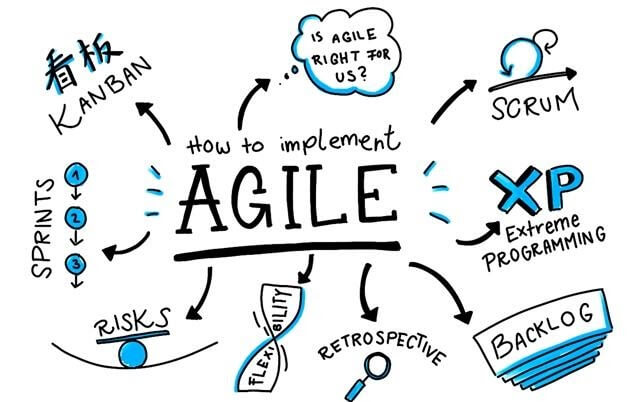
[Source]
What is Agile?
In today’s world, people tend to bring up this word whenever they want, especially if they are trying to sell you something. In reality, this philosophy is neither a methodology nor a particular way of creating a solution. Essentially, it is a set of beliefs and ethics that serve as a North Star for dev squads. This collection of ethics was compiled and perfected back in 2001 in The Manifesto for Agile Software Development.
Usually, when workers are discussing this philosophy, they see it as different Agile practices or tools which do not reflect this culture, instead, they help crews to follow Agile. Once you get it, it becomes clear that this philosophy is a chain that consists of three elements:
- A collection of beliefs
- that facilitate decision-making
- Which helps the team create an application.
Although the term is prone to overuse, it also means that it is a flexible notion. This system does not adopt decisions for you, instead, it serves as a beacon for the squad on the way to improved software development.
What is Agile in project management?
If this sounds too fancy or too software-wise, don’t worry. Although lots of task supervision Agile methodologies are software-driven, the main morals of this task supervision are beneficial for various roles and job positions from mentors to salespeople.
Anyway, what is programming creation in this context? As the name suggests, it is mostly a flexible way of creating a solution. If you use this philosophy in management, the whole process is broken down into several smaller stages or phases.
Therefore, this method allows dev squads to release segments of the solution that are already completed. Opposed to the traditional dev performance, Agile is not result-driven, it focuses on providing sections of a solution. Additionally, with this type of philosophy in mind, the PM doesn’t have to be a one-man or one-woman show.
4 main values of Agile project management
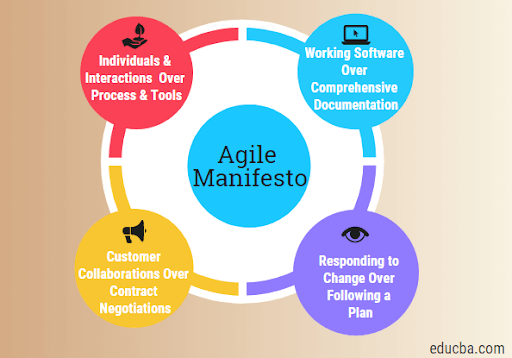
[Source]
Let’s ride a time machine to go back to 2001 when The famous Manifesto was born. At that time, a group of visionaries met up at a ski resort to share their thoughts and figure out why lots of ventures fail. The discussion didn’t just boil down to documenting best Agile practices. Instead, this meeting shifted the industry by stating four fundamentals ethics that serve as a chassis for modern software creation. Without further ado, let us give you an overview of the main values of Agile task managing:
- Individuals and interactions over processes and tools.
This statement does not urge you to forget about phases and tools completely. It just means that a good old face-to-face discussion should beat inflexible workflows and impersonal types of communication.
- Operating application over extensive documentation.
Traditional software development is known for generating large piles of documentation even before the app is released for early evaluation. Old-school documentation might be helpful at some point, but wouldn’t it be ideal to have a tool rather than a book that documents the processes?
- Client cooperation over contract negotiation.
Usually, a contract confines clients as it pinpoints the exact details of the work cycle even before it starts. Instead, it is more beneficial for the company and clients to cooperate to hunt for greater solutions.
- Responding to a change over following a plan.
Sounds like a mantra, right? Nothing in life goes according to a plan, let alone complex creation activities. It is constantly going to throw curveballs at you. Therefore, it is more logical to make adjustments as you go, instead of sticking to a plan that doesn’t do well.
It is quite challenging to weave these ethics into your everyday job activities, but once you do, both your crew and clients will be amazed at the transformation.
In general, these cornerstones are at the core of Agile task managing techniques, guiding everything from common ways of working to the twelve Agile management principles.
The one thing that is echoed in each of the values is that each of them is collaborative and people-centered. The same goes for job activities that push the human element forward. Hence, the final solution is bound to provide the most worth to the end-user.

Core Agile Principles
You cannot succeed in Scrum, Kanban, or any other framework unless you dive into and live by core ethics and beliefs. Whereas the points mentioned above are publicly known, key agility principles are less well-known.
Principle 1. Our prime concern is to meet the client’s objectives through early and continuous delivery of valuable software.
At the end of the day, customers pay for operating and valuable product solutions. Therefore, events, technical gurus, and other things that bring devs to creating an app do not matter unless you live up to your customer’s expectations.
Principle 2. Welcome the evolving requirements even late in development. Agile cycles harness change for the customer’s competitive advantage.
This philosophy embodies empirical knowledge. This way, devs hone their skills and clients will get a deeper insight into their own demands. Also, chances are that in the middle of the software development cycle, you’ll learn that the plan is not viable or impossible. Hence, evolving guidelines call for an information-based and practical system.
Principle 3. Deliver operating software frequently from a couple of weeks to a couple of months with a preference for a shorter timescale.
The more often you deliver software, the lower your release risks are. The more often you submit software, the higher your odds of leveraging the client’s feedback.
Principle 4. Business people and devs must cooperate on a daily basis throughout the process.
Please, do not run screaming. We know the struggle of many daily meetings and other collaborative stuff. But, if at least a PO meets with the devs on a daily basis to specify the guidelines and eliminate hurdles, it will boost job satisfaction and benefit performance.
Principle 5. Organize job activities around motivated individuals. Give them the environment and support they ask for, and trust them to get the job done.
Motivation, job satisfaction, and a sense of person are three cornerstones for any organization. Articulating a powerful ‘why’ is a supreme obligation of the companies’ leaders. The leaders should put their utmost efforts in expanding their employees’ full potential so that the workers have the means to provide a top-notch result. Additionally, instead of controlling every single detail, clients and leaders should allow some space for genius.
Principle 6. The most efficient and effective method of channeling information to and for a dev squad is face-to-face conversation.
This idea overlaps with the first point. Dev specialists should not let piles of written documentation get in the way of personal discussion. Many job activities should be built around client cooperation and not contract negotiation.
Principle 7. Functioning software is the primary measure of progress.
The universal criterion of progress is measuring things that are finished. Software is at its final stage when it is tested and presented successfully. And we are not talking about “90% of coding done”. It is finished when it is tested and accepted by the client.
Principle 8. Agile processes promote sustainable development. The sponsors, devs, and users should be able to maintain a constant pace indefinitely.
Software development should feel more like a marathon rather than back-to-back sprints. Over-the-top effort can rapidly deplete workers and compromise job activities.
Principle 9. Continuous attention to technical excellence and good design enhances agility.
A lack of proper code supervision, testing, and deployment, rapidly undermines the crew’s performance. On top of that, bad design decisions can stymie a team and lead to defects and technical debt.
Principle 10. Simplicity – the art of maximizing the amount of work not done – is essential.
The more elements for bad architectural decisions there are, the more complex software is. The more complex software development is, the harder it is to test, develop, and maintain the code. Overall, it is more beneficial to create a specified solution that is great at a few things and caters to a specific group of users.
Principle 11. The best architectures, requirements, and designs emerge from self-organizing teams.
The ability of any specialist to self-organize around the goals is crucial to all Agile implementations. Although it is challenging for a group of random individuals to self-organize, the right skill balance, domain knowledge, and diversity will do the job.
Principle 12. At regular intervals, the team reflects on how to become more effective, then tunes and adjusts its behavior accordingly.
This is by far the most crucial axiom of all. All the ethics and beliefs were born after expert crews applied empirical processes to get the best of their experience. Therefore, the company should always lay stress on continually upgrading their skills and performance so they can continually grow and improve.
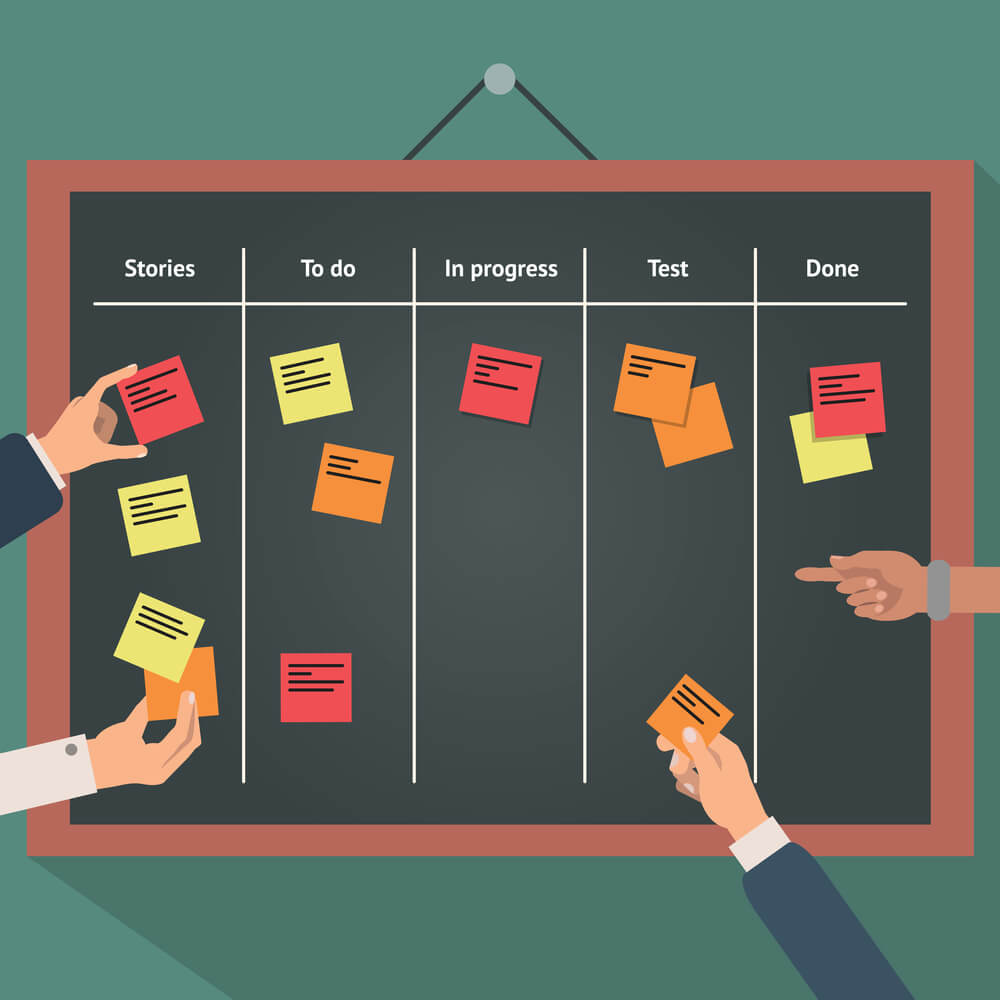
Want to Learn More About The APP Solutions Approaches In Project Development?
Download Free EbookBenefits of Agile methodologies
Now that we’ve broken down what Agile task supervision really is, let’s have a look at some benefits that this method provides:
Stakeholder Engagement
This system leaves much space for stakeholders and devs to collaborate at any phase of the sprint. Enhanced cooperation between the client and the dev squad ensures that the devs tap into the client’s mind. Also, early and frequent delivery strengthens clients’ trust and motivates them to be fully committed to the workflow.
Improved transparency and better visibility
This innovative philosophy serves as an opportunity for a client to be engaged in the software development activity, from planning and prioritizing to regular updates. Nevertheless, a client should be well aware of the fact that they are watching the creation process in progress, hence there is no need to push the workers.
Expected and early Delivery
Time-bound and established sprints of 7-30 days allow the specialists to provide updated elements fast and regularly with predictability being at the highest level. This also means that software can be released and beta tested ahead of the schedule if required.
Enhanced consistency through better risk supervision
Since each sprint is a fixed term, the cost is unsurprising and restricted to the number of tasks that can be performed by the group in the fixed-plan time box. Alongside evaluations given to the client before each sprint, the customer can more promptly comprehend the average cost of each element, which improves dynamics about the importance for elements and guidelines for extra cycles.
Leaves place for modifications
While the group has to remain focused on providing a consented subset of the item’s features during each cycle, there is the chance to continually refine and reprioritize the general item build-up. New or updated stockpiled things can be scheduled for the following cycle, giving the chance to present shifts in a few weeks.
Allows a user-centered mindset
Agile usually utilizes user stories with business-centered admission requirements to perfect highlights. With a user-driven philosophy, each element adds worth, not just an IT segment. This likewise gives the chance to beta test the app after each sprint, increasing valuable input right off the bat as you go, and giving the capacity to adjust things as you go.
Improves Quality
By separating the task into doable units, workers can focus on superior building, evaluation, and joint effort. Likewise, by delivering continuous builds and directing surveys during each iteration, quality is improved by finding and fixing bugs rapidly and recognizing expectation disparity early.

Drawbacks of Agile practices
Continuous Involvement
This system requires the continuous involvement of specialists and business users. This often appears to be extremely challenging, as on-going operations presuppose allocating lots of hours to business meetings and regular cooperation. Therefore, most clients won’t be able to participate in the ongoing process as much as specialists require it.
Also, constant feedback may lead to the deadline dragging out, thus creating a threat of infinitely continuing work. If the client sees only the outcome but has no idea about the effort required to achieve them, he or she will always require improvements.
Lack of documentation
Reduced document load is a two-edged sword for the Agile development process. If the resource moves from one solution to another, or one company to another, it’s difficult for the new resource to use the right transition of knowledge.
Additionally, the urge to adopt the task documentation to the evolving conditions leads to a lack of information. Hence, documents with functional requirements or architecture may not be relevant at a given period.
Lack of processes
With the Agile system, dev crews do not follow lots of processes. As a result, specialists may not allocate enough hours or things perspective-wise and skip some crucial things or stages.
What are the main Agile Lifecycle Phases?
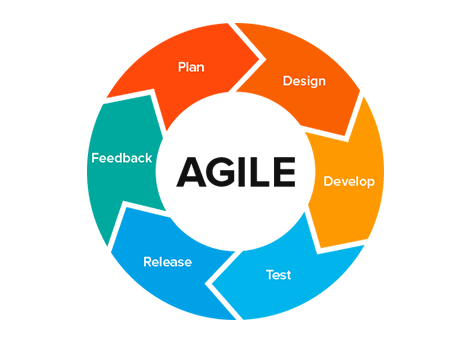
[Source]
The SDLC in this context can vary depending on the type of organization and job activities. Generally, a life cycle can have the following phases:
Phase 1: Requirements
Above all, the specialists and client create the initial documentation. Therefore, an Agile cycle starts with establishing the vision, high-level planning, and defining high-level requirements (backlog). High-level requirements are usually based on user stories. They also include the outcome, supported elements, and those highlights that won’t be supported initially.
Tip: Try to cut the initial guidelines as much as possible, focusing on the essential elements and skipping extra ones.
If the workers jump to another step without outlining guidelines, this can lead to feature creep. In this case, extra elements will inevitably be added to the workload, stealing precious task hours.
As the dev process proceeds, the devs and client will reconsider and update the guidelines.
Phase 2: Design
Software development design boils down to the following types – the app design and UI/UX design.
Design
During the primary cycle, the Product Owner gathers their dev squad and presents the guidelines outlined during the past stage. At this point, the group talks about how to handle these guidelines and proposes the tools required to accomplish the best outcome. This can include computer language, systems, and libraries.
UI/UX Design
At this phase, the designers create an unrefined pilot model of the user interface. If the application is consumer-centered, the UI and UX are the most crucial elements. So, competitor research is an excellent way to define the forte and weak points (especially weak points!). Further iterations entail the design down drilling to meet the outlined guidelines.
Phrase 3: Development and Coding
The third phase basically comes down to crafting code and transforming the design documentation into tangible software. Being the foundation of the whole development process, this phrase requires much time.
Phase 4: Integration and Testing
This phase is about checking that the application is defect-free and operates consistently with the previously written code. The QA crew carries out a sequence of tests to ensure the code is double-checked for bugs and all the business goals are achieved.
Phase 5: Implementation and Deployment
The solution comes together during this phase. The app is deployed on the servers and presented to the audience as a test version or final version. During further iterations, the present application can be updated or amended.
Phase 6: Review
After all the phases are finished, the PO calls for a meeting with the dev squad. They evaluate the achieved progress and present their ideas regarding possible issues.
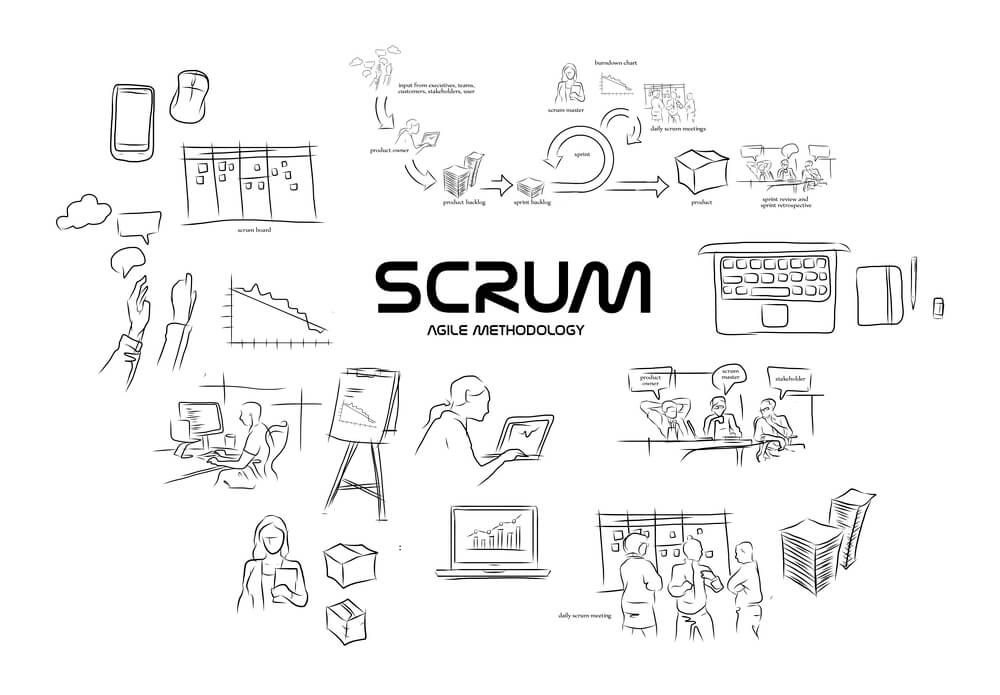
Main differences between Agile and Scrum
Agile and Scrum are two approaches that have become popular in recent years, and for a good reason. Together they make task managing and development more streamlined, faster, easier, and more cost-effective. However, although sharing some similarities, these techniques are different.
Agile is a philosophy based on the ethics and beliefs described in the Manifesto. This methodology is flexible and is the exact opposite of the heavyweight Waterfall.
The first and most important thing that Agile is known for is that adjustments can happen every day and, therefore, you have to be dynamic and ready to react quickly. At the same time, the minimal updates concern the documentation.
It should be noted that due to this dogma, Agile, in most cases, is not suitable for tasks with tight deadlines and budgets. Secondly, strong communication improves the quality of work and makes tasks predictable. Daily meetings and reports discipline the flow and allow the team to plan the task schedule clearly.
Let’s now have a closer look at the second framework.
Essentially, Scrum is a scaled Agile framework that implements beliefs that can be used to handle iterative and incremental tasks of all types. For each task, there is a selected set of specialists from different areas (7-9 people), which includes two extra roles – the PO and Scrum-master.
PO is a link between the team and the client and operates Backlog. The backlog includes Stories, Bugs, Task, ranked by priority (highest, high, medium, low). The Scrum-master is in charge of organizing the development process itself. He or she assigns roles and holds meetings, handles daily problems, motivates the workers, and ensures that Scrum standards are observed.
The initial and main point in the processes is that the whole process is broken down into small equal intervals – sprints, lasting on average from 1 to 3 weeks. The length of iteration depends on the complexity of the Sprint. Before the sprint starts, tasks are submitted to the upcoming Sprint Meeting on which the backlog of the sprint is formed.
And at the end of the sprint, the specialists evaluate the results (Sprint Review). Sprints are often compared with each other to boost performance (Retrospective).
Also, with a Sprint, another process unfolds, which is the Daily Meeting. There, the devs discuss progress made, plans, and potential hurdles. Efficiency in this framework is measured by the time a card from Todo has moved to Completed. The less, the better, if more, the crew has to react and adopt measures to optimize your workflow. Scrum is good for leading a self-organizing dev squad. By using this approach, workers cultivate self-sufficiency and responsibility.
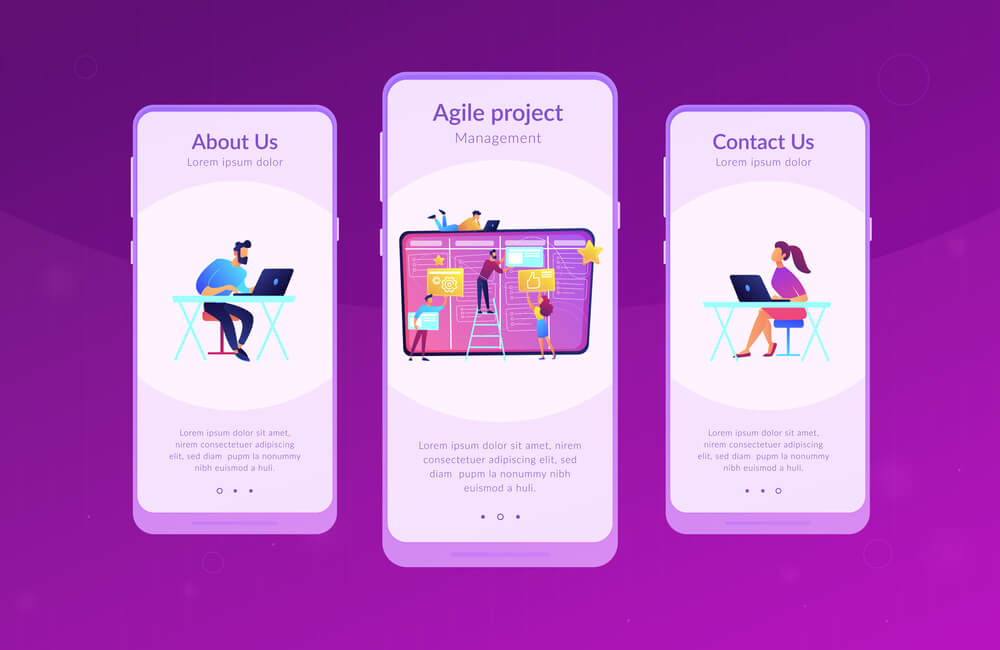
Agile project management: is it right for you?
This philosophy is sweeping the nations and reshaping the IT industry. However, it is not a one-size-fits-all option.
Anyway, when is Agile the right option for your team?
When prerequisites are not clearly outlined.
With this approach, workers don’t have to spend precious work hours on outlining requests that do not always meet the client’s expectations. This means that software development is given an early start. This also allows the PO to envision the elements quicker and provide fast feedback to release the application sooner.
Programming tasks are created for Agile.
As this philosophy means breaking down the project into manageable parts, specific elements can be built, tested, and delivered ahead of schedule. Therefore, these elements can be planned for evaluation and deployment independently, giving an opportunity to schedule the development as effectively as possible.
Co-located workers make use of an Agile system.
The indispensable element of this system is day-to-day meetings. They allow the crew to brainstorm ideas, review the progress made, discuss roadblocks, and client feedback. It is ideal to have face-to-face meetings as opposed to impersonal tools. Crew players who work together can access and refresh the board at any point which enhances cooperation.
Take-charge POs.
The immediate reaction is imperative on the road to success in Agile. This eliminates burdensome documentation that doesn’t always reflect the genuine requests of the PO.
PO that is pro-active and provides the development team with consistent input helps the dev crew to craft the needed solution quicker. Product owners should be present at day-to-day gatherings and articulate their expectations, preferences, and needs. This, in turn, helps the dev squad fine-tune the final version to the owner’s needs.
Synergy and cooperation—team members who play the leading role.
Social commitment and involvement are prime movers in the Agile framework. Agile tends to set a mood where all workers partially accept their responsibilities. The system also calls for engaged and leading crew members. If a teammate isn’t committed to a proactive and aware work process, other workers step up to help and set an example for each other.
Desire to learn from failure.
As the saying goes – the person who falls and gets up is stronger than the person who never tried. Crafting prototypes and providing reactions are vital tools in Agile development. As opposed to the common system, Agile doesn’t chart all requests before the creation process starts, which turns out to be more time-effective. So instead of hindering development, the team dives into creating right away, even if it is not exactly the solution the PO expects it to be. Feedback over contract – remember?
Management support of the Agile system and its philosophy of empowering teams.
Agile can reshape the culture and undermine the expectations of the whole company since it allows members to play the leading role. On the other hand, the traditional framework offers a more definite direction instead of empowering the workers with decision-making. The board must give the scope, which is important to enable the squad to flourish, by giving a direction and course, and do whatever is necessary, rather than direct every move.
The grasp of Agile is energizing. It gives one more instrument in the project supervision toolbox with which to address the advancement of a project. Like any tool, there are tasks that it’s great at, and those for which it isn’t intended. Be that as it may, we’re generally better leaders when offered a wider choice.
Want to receive reading suggestions once a month?
Subscribe to our newsletters